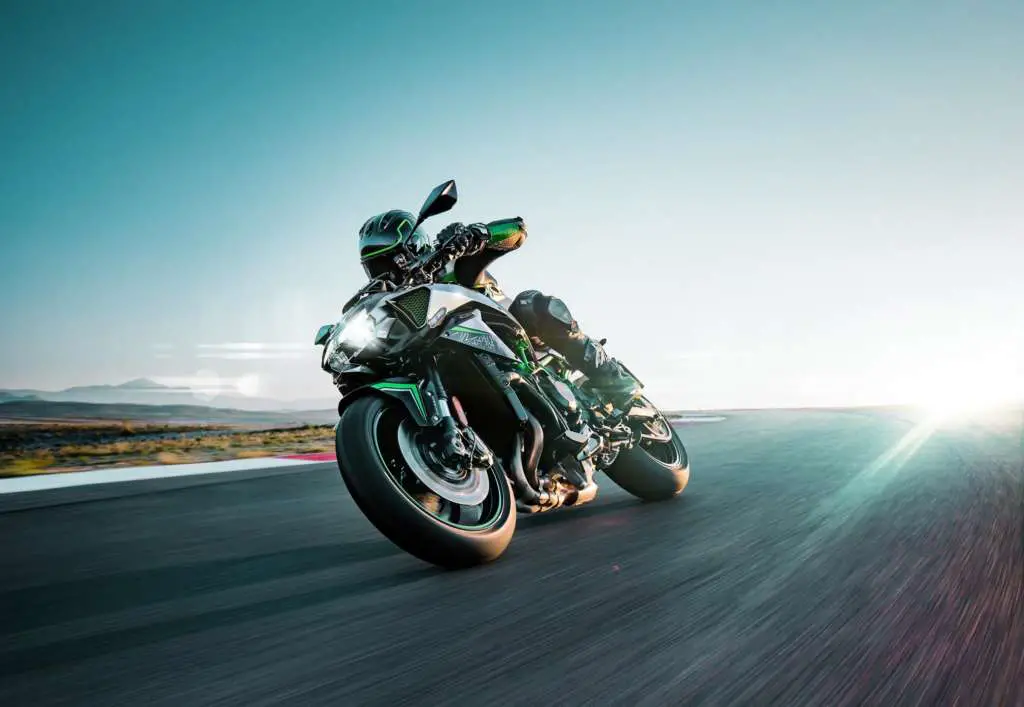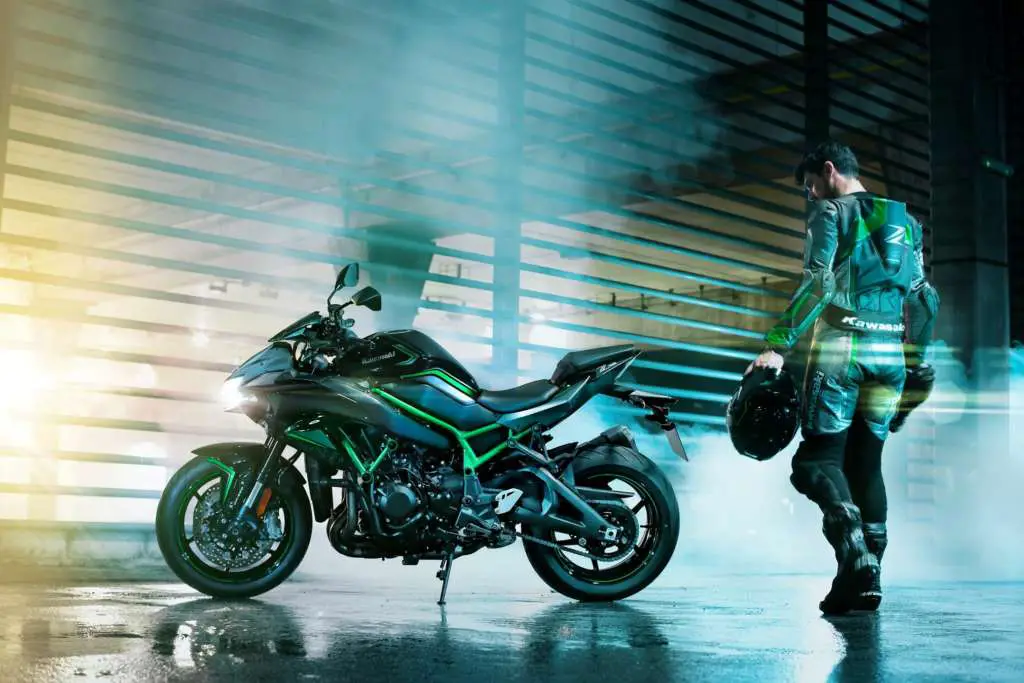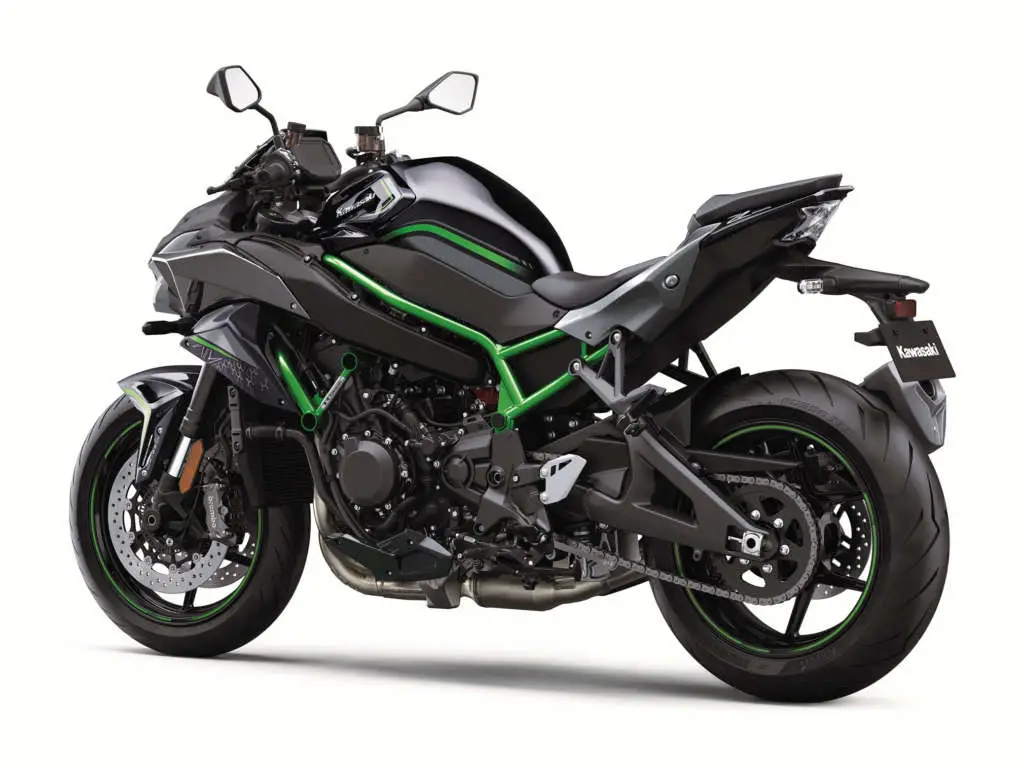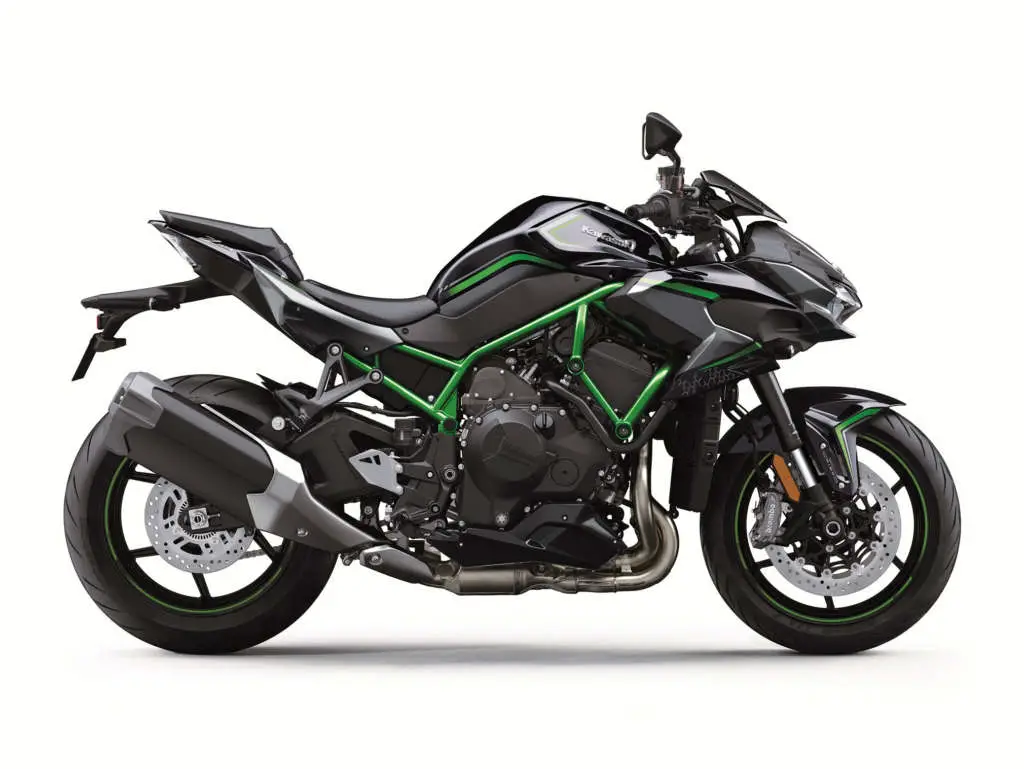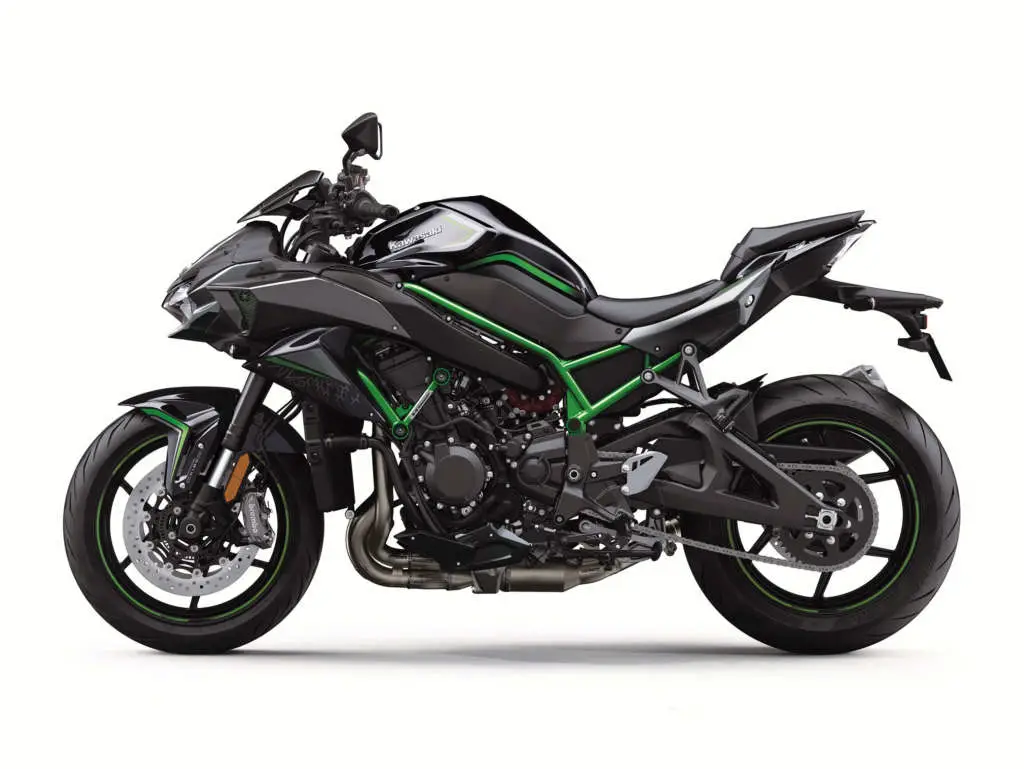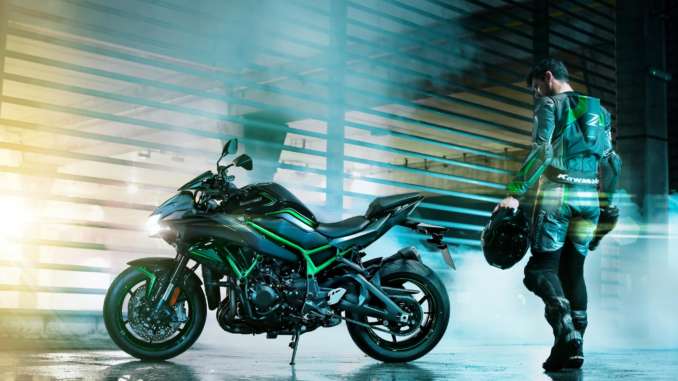
2020 Kawasaki Z H2 : THE FLAGSHIP OF THE KAWASAKI Z LINE.
2020 Kawasaki Z H2.
Kawasaki’s legacy of creating motorcycles that have unrivaled performance, excitement, and Sugomi™ styling continues with a flagship model of the Kawasaki Z line of naked motorcycles, the all-new 2020 Z H2 supercharged hypernaked. With the arrival of the hypernaked Z H2 and its powerful, balanced supercharged engine, the second chapter of Z history is about to begin and marks the beginning of a new era.
The 2020 Ninja H2 has done it again with another leap forward in power and technology. The 998cc Supercharged engine puts out even more power, the next generation Brembo Stylema calipers produce unbelievable stopping power, and a full TFT dashboard with Bluetooth connectivity ensures you are connected in ways you never thought possible. It even has highly durable paint that heals itself from minor scratches in the sun. Adding these to an already awe-striking package, it’s no wonder that the H2 is Built Beyond Belief.
With a Balanced Supercharged Engine that delivers exhilarating power, a highly responsive trellis-framed chassis that harnesses that power, everyday riding comfort and a robust suite of electronic riding aids, the all-new Kawasaki Z H2 takes its place as the flagship of Kawasaki’s Z branded lineup.
SUPERCHARGED Z: BEGINNING OF A NEW ERA
998cc, BALANCED SUPERCHARGED ENGINE
EFFORTLESS DOG-RING TRANSMISSION
SPECIFICALLY DESIGNED, LIGHTWEIGHT TRELLIS FRAME
IMU ELECTRONICS PACKAGE
2020 Kawasaki Z H2 Totalmotorcycle.com Key Features
- High Performance Showa Suspension Components
- Brembo® Monobloc Brake Calipers
- Kawasaki Quick Shifter (KQS)
- Kawasaki Launch Control Mode (KLCM)
- Kawasaki Cornering Management Function (KCMF)
- Electronic Cruise Control
- Integrated Riding Modes
- Assist & Slipper Clutch
- All Digital TFT Color Instrumentation
- Smartphone Connectivity via RIDEOLOGY THE APP
- All LED Lighting
2020 Kawasaki Z H2 Totalmotorcycle.com Features and Benefits
ENGINE
Based on the supercharged engine of the Ninja H2™ motorcycle, the Balanced Supercharged Engine achieves a balance of power for exhilarating acceleration while providing better fuel efficiency and more street-oriented performance.
Supercharged Intake
- Kawasaki designed and built centrifugal type supercharger has a high pumping capacity.
- Planetary gear gets driving force from the crankshaft and spins a 69mm impeller that was specially designed using Kawasaki Gas Turbine and Aerospace technology.
- Since the supercharger design is highly efficient, compressed intake air is minimally heated so no intercooler is necessary.
- Ram air intake duct feeds the supercharger fresh air in as straight a line as possible to help provide high output.
- Aluminum intake chamber between supercharger and throttle bodies helps radiate heat to keep intake air cool.
- The frontal area of the left-side intake is designed to match the airflow requirements of the Balanced Supercharged Engine. The intake duct feeds the supercharger fresh air in as straight a line as possible to contribute to the supercharger’s efficiency.
- The 69mm supercharger impeller was designed to optimize blade shape and angle for the Balanced Supercharger Engine broad power characteristics. Settings for rpm and airflow volume for maximum efficiency were also optimized.
- Formed from a forged aluminum block using a five-axis CNC machining center to ensure high precision and durability, the impeller has six blades at the tip expanding to 12 blades at the base. Grooves etched into the blade surfaces help direct airflow.
- Planetary gear train, specially designed using Kawasaki Gas Turbine and Aerospace technology, is driven by the crankshaft and increases the impeller speed to 9.2 times that of the crankshaft.
- Aluminum intake chamber between supercharger and throttle bodies has optimized volume, die-cast construction and diffuser at the mouth of the chamber that contribute to overall supercharger efficiency, engine performance and fuel efficiency. A stainless steel net at the end of the diffuser helps smooth airflow.
- Optimized and irregular intake funnel lengths help boost low- and mid-range performance. The funnels for the outer cylinders are shorter than those in the middle.
- ECU-controlled blow-off valve regulates pressure gain in intake chamber when throttle is closed to prevent impeller surging and help prevent vibration. Quick valve operation response maintains optimum boost pressure to contribute to power feeling and throttle response.
- A sound hole in the intake duct allows the rider to enjoy the supercharger’s characteristic chirping.
Engine
- Using race technology developed for the multi-time World Superbike Championship winning Ninja® ZX™-10R, a two-stage machining process for the cylinder head forms the throat of the intake ports. The valve seat area is bored twice: once along the same path as the throat; then again for the valve seats. The result is smoother intake airflow, which helps reduce intake loss and increases performance.
- Cam profiles match the airflow requirements of everyday street riding, contributing to the low-mid range focused performance as well as fuel efficiency.
- Intake and exhaust ports match the airflow to boost low- mid range performance and fuel efficiency.
- One-piece cylinder/upper crankcase utilizes dummy cylinder head during honing process for more precise cylinder dimensions, which allows use of low-tension piston rings to reduce mechanical loss and boost engine response.
- High compression ratio increases thermal efficiency and greatly contributes to fuel efficiency.
- Efficient combustion produces less heat so that the pistons can be cooled by a single oil jet, allowing the oil pump to turn at a slower rate to minimize friction loss. This also allows the engine’s oil volume to be optimized which contributes to weight savings.
- Large, deep-sump oil pan helps cool oil. Oil pan design ensures the oil pump is always surrounded by oil to prevent cavitation. Additionally, the unique angled shape and position of the oil strainer also helps prevent cavitation during strong acceleration and deceleration.
- Dual secondary balancers virtually eliminate engine vibration.
Engine Sound Tuning
- Acoustic analysis used to shape the intake duct, tune the operating sound of the supercharger and the intake sound to produce an engine sound that is unique to the Z H2.
All-new Exhaust System
- New chamberless exhaust system with longer header pipes helps boost low and mid-range power.
- Minimal muffler size helps reduce weight.
- 40mm Electronic Throttle Valves enable the ECU to control the volume of both the fuel (via fuel injectors) and the air (via throttle valves) delivered to the engine. Ideal fuel injection and throttle valve position results in smooth, natural engine response and the ideal engine output. The system also enhances input to the traction control system and accommodates the Kawasaki Launch Control and Kawasaki Engine Brake Control features.
- ETV allows cruise control system to be implemented so that a desired speed can be maintained with a push of a button for added touring comfort.
- The throttle pulley operates an Acceleration Position Sensor (APS) that uses the ECU to send a signal to a small motor that operates the throttle valves. This makes throttle pull very light for reduced rider fatigue.
Cruise Control
- Electronic cruise control has single-button activation to maintain selected speed, which can also be adjusted with adjacent up/down toggle.
Transmission
- Dog-ring transmission uses MotoGP technology in which the gears are fixed to the input transmission shafts and rings move to engage the gears on the output shaft. The result is lighter shifting, improved feel and quicker shifts.
- Transmission oil jets aimed at every gear mesh and shift fork position provide direct cooling and exceptional lubrication for high durability.
- Primary gear ratio designed to contribute to fuel efficiency, while helping to reduce the torque load on the transmission gears. First and second gear ratios also contribute to engine manageability in most everyday riding situations.
Kawasaki Quick Shifter (KQS)
- Contact-less potentiometer-type quick shifter for quick upshifts that enable seamless acceleration without backing off the throttle.
- During deceleration when the throttle is completely closed and engine speed is not near redline, KQS automatically controls engine speed to allow downshifting without operating the clutch lever.
Assist & Slipper Clutch
- Using the rotational forces of the clutch hub and pressure plate, the clutch is forced together during acceleration (Assist function) so that fewer and lighter clutch springs can be used for a lighter feel at the lever. During high back-torque, such as when too low of a gear is selected during downshifting, the Slipper function allows some clutch slippage to help prevent engine lock-up, stalling and rear wheel hop.
SUSPENSION
KAWASAKI NEXT LEVEL ELECTRONICS
- Kawasaki’s cutting-edge electronics have always excelled on the track due to the highly sophisticated programming that gives the ECU an accurate, real-time picture of what the chassis is doing using minimal software. With a Bosch IMU and the latest evolution of Kawasaki’s proprietary dynamic modeling software, the Z H2 motorcyle’s electronic management technology is next level, changing from setting-type and reaction-type systems to feedback-type systems.
Inertial Measurement Unit (IMU)(KP)
- The IMU measures inertia along 5 axes: acceleration along longitudinal, transverse and vertical axes, roll rate, and pitch rate. The yaw rate is calculated by the ECU using Kawasaki’s patented software to provide six-axis chassis attitude input of lean angle and acceleration/deceleration force for more precise management of the electronic riding aids.
- The IMU allows KTRC to incorporate more feedback to help maximize acceleration when exiting corners on the track.
- Unlike competitors’ systems that have pre-set limits, Kawasaki’s proprietary race-developed software enables the Z H2 to have a dynamic system that has a higher level of chassis awareness and adapts to changing conditions such as rider inputs, vehicle attitude, and pavement conditions.
Kawasaki Cornering Management Function
- Corner Management Function uses both KIBS and KTRC to assist riders in tracing their intended line through a corner by suppressing the tendency for the bike to stand up while braking in a turn. The IMU helps the system maintain optimum hydraulic pressure based on the bike’s lean and pitch angles.
Kawasaki Launch Control Mode (KLCM)
- Designed to assist the rider by optimizing acceleration from a stop, KLCM electronically controls engine output to help prevent wheelspin and thereby minimize front end lift when launching from a standstill.
Kawasaki Traction Control (KTRC)
- Mode 1 prioritizes forward acceleration, while Mode 2 offers a balance between acceleration performance and rider reassurance. Mode 3 provides rider reassurance by facilitating smooth riding on slippery surfaces.
- The system confirms conditions every 5 milliseconds and uses ignition cut and airflow control (via the electronic throttle valves), enabling extremely quick reaction.
- Using complex analysis, the system monitors traction conditions. By acting before slippage exceeds the range for optimum traction, drops in power can be minimized, resulting in ultra-smooth operation.
Power Modes
There are three modes to allow riders to select power delivery to suit preference and conditions. Full: Full power operation
Middle: Limited operation, about 75% of full Low: Limited operation, about 50% of full
Integrated Riding Modes: Sport, Road, Rain, Rider (manual)
- All-inclusive modes that link KTRC, Power Mode and KECS allow riders to efficiently set traction control, power delivery and suspension character to suit a given riding situation.
- Riders can choose from Sport, Road, Rain or a manual setting (Rider). In the manual Rider mode, each of the systems can be set independently.
– Sport: enables riders to enjoy sporty riding on winding roads.
– Road: offers comfortable riding over a wide range of situations, from city riding to highway cruising and rural roads.
– Rain: offers rider reassurance when riding on a wet road surface.
CHASSIS
All-new Trellis Frame
The Z H2 motorcycle features an innovative trellis frame like the Ninja H2™ and it is designed exclusively for the Z H2 to enhance performance at highway speed while easing low-speed maneuverability.
Trellis frame is made of high-tensile steel with pipe diameter, thickness and bend of each piece carefully selected to obtain the optimal stiffness for that part.
The engine is tilted forward to help lower the center of gravity, which contributes to overall handling as well as stability at highway speed.
Slim frame design and horizontal mounting of the die-cast aluminum rear sub-frame helps keep seat narrow and contributes to an easier reach to the ground for the rider’s feet.
Open design of trellis frame allows air to pass through it to help dissipate engine heat.
Swingarm mounting plate is bolted to the back of the engine to make it part of the frame. This eliminates frame cross members helping keep the frame light and enabling the chain tension generated by the high-output engine to be efficiently transferred to the rigid engine block.
SUSPENSION
- With springs in both legs, preload and damping functions are separated into the right and left fork tubes. Preload adjustment is made on the left side, compression and rebound damping on the right. All adjustment screws are at the top of the forks for easy access.
- Large 37mm pistons produce high damping force for improved performance during heavy braking.
- Suspension settings idealized for winding roads and city riding while maintaining high performance on the track as well.
- Uni-Trak lever ratios and shock damping settings offer a plush ride on the street and highway.
- Cast aluminum swingarm has a perfect balance of stiffness and flex and works with the frame’s stiffness balance to provide exceptional handling.
- Brembo M4.32 monobloc calipers are lightweight and highly rigid for better braking performance.
- Radial-mounted 4-piston brake calipers, radial-pump brake master cylinder and big 320mm brake discs provide impressive braking performance and superb feel.
- Rear brake features twin piston caliper that clamp a 250mm disc.
- KIBS high-precision anti-lock brake system provides smooth feedback and minimal lever movement for added braking confidence.
- The engine ECU communicates with the compact ABS ECU (which monitors wheel speed and front caliper hydraulic pressure) to provide highly precise brake pressure control. The high precision control means brake performance is not reduced due to excessive pressure drops and there is a more consistent lever feel instead of sharp lever pulses felt with conventional ABS systems
All-new Sugomi Design
The Z H2’s aggressive styling is inspired by the sugomi styling concept. Sugomi describes the intense aura or energy given off by a person or object of greatness and felt by the viewer. Someone, or something, possessing sugomi inspires awe, leaves an indelible impression, is daunting in stature or ability, and commands respect. Elegant bodywork flowing from head to tail is combined with minimalist coverage in the engine area is devised to draw attention to its functional beauty. A condensed appearance emphasised by slim, close-fitting bodywork gives the bike a light, agile image that reflects its sporty performance.
INSTRUMENTATION
- High-grade full color multi-meter display features TFT (thin-film transistor) technology to ensure a level of visibility previously unattainable. The screen’s background color is selectable (black or white), and screen brightness adjusts automatically to suit available light. In addition to scrollable multi-function windows, two display modes offer riders a choice of how they want their information presented.
RIDEOLOGY THE APP Smartphone Connectivity†
† Do not operate smartphone while riding
- A Bluetooth® chip built into the instrument panel enables riders to connect to their motorcycle wirelessly. Using the smartphone application “RIDEOLOGY THE APP,” a number of instrument functions can be accessed, contributing to an enhanced motorcycling experience.
Available functions:
– Vehicle Info: information such as fuel gauge, odometer, maintenance schedule, etc can be viewed via the smartphone.
– Riding Log: GPS route information as well as vehicle running information can be logged and viewed via the smartphone.
– Telephone notices: when a call or mail is received by the smartphone, this is indicated on the instrument display.
– General Settings: general instrument display settings (such as preferred units, date, date format, etc) can be adjusted via the smartphone.
– Vehicle Settings: Riding Mode (Road, Sport, Rain, Rider) can be set in advance on the smartphone and uploaded when in proximity of the bike, as can riding support systems (like KQS) and the payload mode.
- Once vehicle information has been downloaded to the app, it can be viewed on the smartphone. Available information includes: odometer, trip A, trip B, fuel gauge, remaining range, average gas mileage, average speed, max lean angle (right/left), battery voltage, Kawasaki service reminder, oil change reminder, etc.
- Detailed riding logs including GPS information and vehicle running information can be recorded. While riding, the app tracks vehicle speed, rpm, gear position, throttle position, front brake fluid pressure, acceleration/deceleration, current mileage, and coolant temperature from moment to moment. Once the riding log has been saved, riders can review these items in a graphic-style display at any point along the route. The app can also display a ride summary, with information that may include: route travelled, total distance, total time, gas mileage (best/average), speed (best/average), max lean angle (right/left), etc. For either display mode, riders can select which items are displayed, and can arrange them in their preferred order.
- When riding with the app acctivated, the bike and smartphone are always connected. When the engine is turned off, the latest riding information stored by the app may be viewed on the smartphone.
Any vehicle setting changes made via the app while the engine is off, or while out of range, cannot be uploaded until the ignition is turned on and the smartphone is in range with the app ON. General settings can only be updated via the app when the bike and smartphone are connected.
2020 Kawasaki Z H2 – Totalmotorcycle.com USA Specifications/Technical Details
US MSRP Price: $17,000 USD
Canada MSRP Price: $19,599 CDN
Europe/UK MSRP Price: £ GBP (On The Road inc 20% Vat)
POWER
Engine 4-stroke, 4-cylinder, DOHC, 4-valve, liquid-cooled, supercharged
Displacement 998cc
Bore x Stroke 76.0 x 55.0mm
Compression Ratio 11.2:1
Maximum Torque 101.0 lb-ft
Fuel System DFI® with 36mm Keihin throttle bodies
Ignition TCBI with electronic advance
Transmission 6-speed dog-ring, return shift
Final Drive Sealed chain
PERFORMANCE
Front Suspension / Wheel Travel Showa SFF-BP Fork with Adjustable Compression and Rebound Damping, Spring Preload Adjustability
Rear Suspension / Wheel Travel New Uni-Trak®, Showa Gas-Charged Shock with Adjustable Compression and Rebound Damping,
Preload Adjustability
Front Tire 120/70-17
Rear Tire 190/55-17
Front Brakes Dual Disc w/Radial-mount M4.32 Calipers, ABS
Rear Brakes Single 250mm petal-style disc with single-piston caliper, ABS
DETAILS
Frame Type Trellis, high tensile steel
Rake/Trail 24.9°/4.1in
Overall Length 82.1 in
Overall Width 31.9 in
Overall Height 44.5 in
Ground Clearance 5.5 in
Seat Height 32.7 in
Curb Weight 527.0 lb**
Fuel Capacity 5.0 gal
Wheelbase 57.3 in
Color Choices Metallic Spark Black/Metallic Graphite Gray/Mirror Coated Spark Black
Warranty 12 Month Limited Warranty
Kawasaki Protection Plus™ (optional) 12, 24, 36 or 48 months
**Curb weight includes all necessary materials and fluids to operate correctly, full tank of fuel (more than 90 percent capacity) and tool kit (if supplied). When equipped, California evaporative
emissions equipment adds approximately 2.2 lb.
2020 Kawasaki Z H2 – Totalmotorcycle.com Canadian Specifications/Technical Details
ENGINE
| Displacement | 998 cm3 |
| Type | Liquid-cooled, 4-stroke In-Line Four |
| Bore and stroke | 76.0 × 55.0 mm |
| Compression ratio | 11.2:1 |
| Valve system | DOHC, 16 valves |
| Fuel system | Fuel injection |
| Ignition | Digital |
| Lubrication | Forced lubrication, wet sump with oil cooler |
| Starting | Electric |
| Intake System | Kawasaki Supercharger |
BRAKES
| Front: type | Dual ø290 mm discs |
| Rear: type | Single ø226 mm disc |
DIMENSIONS
| Overall length | 2,085 mm |
| Overall width | 810 mm |
| Overall height | 1,130 mm |
| Wheelbase | 1,455 mm |
| Ground clearance | 140 mm |
| Seat height | 830 mm |
| Curb mass** | 239 kg |
| Fuel capacity | 19 litres |
DRIVETRAIN
| Transmission | 6-speed, return, dog-ring |
| Final drive | Chain |
| Primary reduction ratio | 1.480 (74/50) |
| Gear ratio: 1st | 3.077 |
| Gear ratio: 2nd | 2.471 |
| Gear ratio: 3rd | 2.045 |
| Gear ratio: 4th | 1.727 |
| Gear ratio: 5th | 1.524 |
| Gear ratio: 6th | 1.348 |
| Final reduction ratio | 2.556 (46/18) |
| Clutch | Wet multi-disc, manual |
FRAME
| Type | Trellis, high-tensile steel |
| Wheel travel: front | 120 mm |
| Tire: front | 120/70ZR17 M/C 58W |
| Wheel travel: rear | 134 mm |
| Tire: rear | 190/55ZR17 M/C 75W |
| Caster (rake) | 24.9o |
| Trail | 104 mm |
| Steering angle (left/right) | 29o/ 29o |
PERFORMANCE
| Maximum Power‡ | 147.1 kW {200 PS} / 11,000 min-1 |
| Maximum Torque‡ | 137.0 N.m {14.0 kgf.m} / 8,500 min-1 |
SUSPENSION
| Suspension, front | Telescopic |
| Suspension, rear | Swingarm (New Uni Trak rear suspension) |
2020 Kawasaki Z H2 – Totalmotorcycle.com European Specifications/Technical Details
Manufacturer Specifications and appearance are subject to change without prior notice on Total Motorcycle (TMW).


